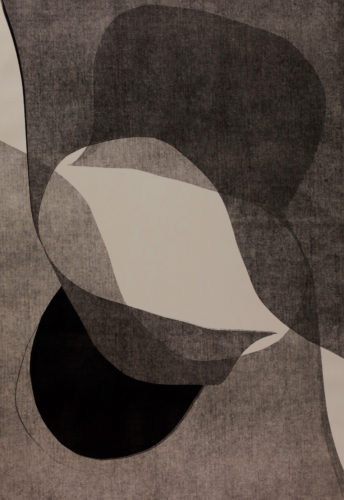from October 26th to 23rd November, 2018 Juliana Matsumura and Maria Albergaria | Evocatório I
In Evocatório, a made up place between two, the works by Juliana Matsumura and Maria Albergaria are shown. Just as opening a trunk or a memory box, we are in a territory that can be perceived as familiar and strange at the same time. The concept of invocation (evocação), beyond implications of memory levels and the unconcious, also includes ancestral human practices, as the invocation of the dead through rituals, inviting them to temporally come back to this world. To invoke is to call the dead, or anything that is absent. The desire of invoking, shared by both artists, is, nevertheless, adressed by very different perspectives.
Juliana Matsumura incorporates to her work a constant worry about the destructive process, both natural and humane (a distinction that in the end, she will not make). Moreover, she makes us think about the way we face different types of destruction. By looking at her paintings the idea of violence or destruction is not obvious, because what is visible, the remaining (remanescente, title of a series of her 2017 paintings), is subtle and soft, making it difficult to identify it in the end, and that is the nuclear objective. The paintings invoke not only a destruction that transforms and creates matter, as an earthquake, but as more subtle types of destruction, like ground erosion, the aging, the forgetting or the lose of visual information.
Maria Albergaria’s work relates to this through the use of gold — more specifically gold leaf—, which was commonly used in medieval illustrations and carving, a technique whose existence is usually forgotten. The artist uses the idea of Gold to put together pieces that go back to a time where the metal held a huge symbolic value and it represented the economic power, delimitting the social status and exalting the power of the sacred in religious institutions. Gold has always been a material of creation of antagonisms between those who held the wealth and those who did not, but also between those who had access to Beauty and those who had not. Maria Albergaria, who has experience in restoration, shows her skills, her care and her delicateness, which invoke a past where the artist and the artisan held the same status: the artist was an apprentice or a master of a trade. By reflecting on the past through the medium, she integrates a metal that was present in the best and worst of humankind, in a vast number of their beautiful pieces and in a lot of their terrible crimes, creating a new level of meaning. Trascending this historical context of carving and gold, we can make multiple analises: formal, geometrical, diagrammatical, from the support matterials (as the canvas) and even from a series of squares that echoes multiple contemporary structures.
Both artists achieve to invoke complex questions with their work, even though they do it tangentially, using them as an orientation of their practices and without the will of reaching any descriptive solutions. This, rather than showing shyness, shows a conscious difficulty of thinking of the world in its complexity. By bringing us their work we could think, for example with Sebald, a germanic writer based in England, that this attacks a difficulty of talking about the Holocast, especially for those who had not been direct victims of its terror, by building a thread of stories that works as a frontier, leaving to the reader the work of intuiting what exists in that space that he is talking about, or that we do not know what to say. The fact that these problems have been shown to be so deep for us to, individually, face with enough confidence to tear them down, this should not encourage the artists to stop reflecting about them and producing works that help us think about the world with new tools.
Frederico Parreira
Biographies:
Juliana Matsumura was born in São Paulo, Brazil. She lives and works in Lisbon. The artist concluded the course of Drawing at Ar.Co in 2017, as well as attending the course of Textile and Fashion at the University of São Paulo (2011-2013) and the course of Fashion Design at the University of Lisbon in 2014, with the exchange scholarship of Academical Achievement. She has participated in artistic residences and in collective exhibitions in Brazil and in Portugal.
Maria Albergaria was born in Lisbon, where she lives and works. The artist has attended the course of Decorative Painting at the FRESS in Lisbon in 2001, the course of Peintre en Décors, at IPEDEC in Paris in 2004 and the course of Wall Painting Restoration at the IADE in Lisbon in 2006. In 2014 she was admitted at the Painting Course at Ar.Co, where she is currently studing the Advanced Course in Plastic Arts. During her passage from restoration to artist she acquired a taste for working with gold leaf and she elaborates her pieces through the experience she had with golden carving.

